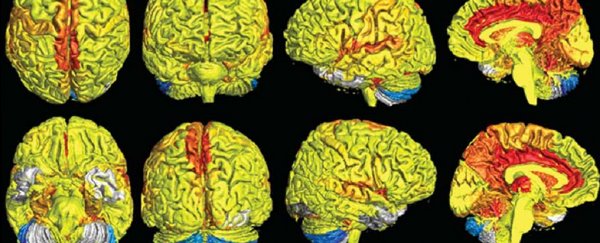Scientists have discovered a new difference between the sexes: women's brains seem to be more active than men's brains, in terms of blood flow through specific regions.
It doesn't mean women can be labelled smarter or deeper thinkers, but it could give us clues to treating brain diseases like Alzheimer's and Parkinson's, and adapting those treatments based on gender.
A team from Amen Clinics in California looked at 46,034 brain scans carried out through SPECT (Single-Photon Emission Computed Tomography) technology, specifically designed to track blood flow through the brain.
"This is a very important study to help understand gender-based brain differences," says lead researcher Daniel Amen, a renowned psychiatrist with a somewhat controversial reputation.
"The quantifiable differences we identified between men and women are important for understanding gender-based risk for brain disorders such as Alzheimer's disease."
 Increased blood flow in women's brains is shown in red. Credit: Amen Clinics
Increased blood flow in women's brains is shown in red. Credit: Amen Clinics
As well as 119 healthy volunteers, the scans covered 26,683 patients with psychiatric conditions, both while the brain was at rest and while it was focussed on a certain task.
Areas where women's brains were found to be significantly more active in terms of blood flow were the prefrontal cortex, which helps with controlling impulses and maintaining focus, and the limbic or emotional parts of the brain, which handle mood and anxiety.
The researchers suggest this could explain why women are often considered more empathetic and intuitive than men (although the extent of this effect varies), for example, and also at a greater risk of developing problems with anxiety.
Women have significantly higher rates of depression and anxiety disorders, while men are more at risk of Attention Deficit Hyperactivity Disorder ( ADHD) and much more likely to end up in prison. The SPECT scans might explain some of those differences.
While there was more blood flow in women's brains overall, male brains had more blood flow in certain areas, including the visual and coordination centres of the brain.
These variations could eventually help us understand why the risk of Alzheimer's and Parkinson's is different between men and women. Part of the reason seems to be that some of the brain's deepest structures age more quickly in the male brain.
Exactly what this higher activity means isn't fully clear to scientists, and likely depends on the region of the brain in question.
"These results do not mean that women's brains are more active, or that women use more of their brains," the neuroscience blogger Neuroskeptic explains over at Discover Magazine.
"All we know is that more blood flows through blood vessels in the female brain. There could be many possible explanations for this."
It is thought that increased blood flow, and the extra oxygen that goes along with it, leads to better brain function – without it, the brain dies – but in the case of this particular study the scientists are focussing on how the findings might help us understand malfunctioning brains.
"Using functional neuroimaging tools, such as SPECT, are essential to developing precision medicine brain treatments in the future," says Amen.
The findings have been published in the Journal of Alzheimer's Disease.
